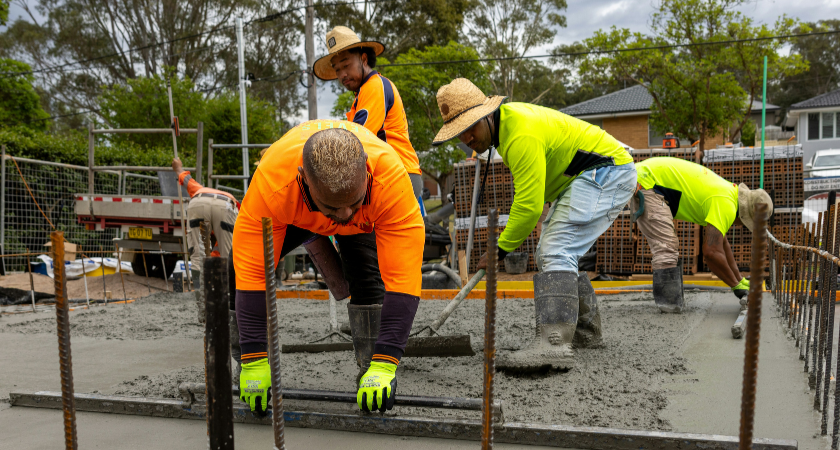
For the first time in over two decades, construction unemployment has fallen below the national average—signaling a seismic shift in the labor market that could redefine workforce dynamics, project pricing, and industry strategy.

According to recent data from the U.S. Bureau of Labor Statistics, construction unemployment ended August at 3.9%, compared to the overall U.S. unemployment rate of 4.3%. It’s the second time this year—and only the third time in more than 20 years—that construction unemployment has dipped below the national rate.
This development underscores how the construction sector, long known for its cyclical ups and downs, is now operating under historically tight labor conditions that may persist well beyond seasonal trends.
Traditionally, construction employment has mirrored the boom-and-bust rhythm of the broader economy, with jobless rates often running higher than the national average during slow periods. But the current numbers defy that historical pattern.
“For the first time since at least 2020, construction unemployment has fallen well below the overall U.S. unemployment rate,” the analysis noted. “This represents a fundamental shift. Historically, construction operated with higher unemployment volatility than the broader economy. Today’s numbers tell a different story.”
The data points to a labor market that is not just tight—it’s being reshaped by external forces such as policy enforcement and demographic changes.
Recent enforcement actions by U.S. Immigration and Customs Enforcement (ICE) may be playing a key role in constraining the available construction workforce. The crackdown has reportedly had a disproportionate impact on construction, an industry that has long depended on immigrant labor to meet workforce demand.
“Recent ICE enforcement actions may be disproportionately affecting the supply of construction labor, adding pressure to an already tight market,” the report said.
As a result, general contractors and trade contractors alike are facing heightened competition for skilled workers—a situation that could drive wages even higher and increase project costs across the board.
Unlike typical seasonal slowdowns, this kind of supply constraint could linger, creating long-term challenges in staffing projects efficiently and affordably.
The skilled labor shortage, which has been one of the construction industry’s biggest challenges for years, now appears to be entering a new phase. With fewer available workers and rising enforcement pressure, companies are being forced to rethink how they attract, train, and retain talent.
“The well-documented skilled labor shortage in trades jobs is clearly shown in the data as worse than ever before,” the report stated. “And now, with enforcement actions potentially reducing the available workforce, companies face an even tighter squeeze.”
For contractors, this means an ongoing battle to fill critical roles while maintaining project timelines. Many are turning to apprenticeship programs, workforce partnerships, and technology-driven productivity tools to offset labor gaps.
.jpg)
For project owners, the effects will likely show up in higher labor costs, extended project schedules, and greater emphasis on preconstruction planning to mitigate workforce risk.
As one analysis summarized, “The construction labor market has entered new territory, and as shortages persist, the implications will ripple through project planning, pricing, and strategy for the foreseeable future.”
As the industry heads into the fall and winter construction cycle, a key question looms: will seasonal hiring patterns help rebalance the labor market, or are we witnessing a structural change that will define construction’s future?
Industry experts believe some seasonal adjustment will occur—but the underlying issues of demographic shifts, immigration enforcement, and declining vocational training participation suggest that the shortage will continue.
“The question isn’t whether labor will remain tight—it’s whether the industry can adapt quickly enough to meet demand,” the report added.
Even if the traditional winter slowdown reduces short-term employment pressures, the deeper structural shortage of skilled tradespeople—from electricians and plumbers to ironworkers and masons—appears here to stay.
The data serves as both a milestone and a warning for an industry already under strain from inflation, material costs, and supply chain disruption. The scarcity of qualified workers could affect construction productivity, bid competitiveness, and project delivery for years to come.
Analysts suggest that companies that invest in training, automation, and workforce retention will be best positioned to weather the tightening labor market. Others may struggle to maintain profitability as wage pressure continues to mount.
In the long run, this shift could accelerate trends toward prefabrication, modular construction, and AI-assisted project planning—technologies designed to reduce dependency on labor while maintaining output.
ConstructConnect has long been at the forefront of construction industry data and market intelligence. Its software and analytics tools provide commercial builders, contractors, and product manufacturers with the insights needed to start every project on solid ground.
“For more than 100 years, our market intelligence has empowered commercial firms, building product manufacturers, trade contractors, and architects to make data-driven decisions,” the company noted.
A subsidiary of Roper Technologies (Nasdaq: ROP), Construct Connect continues to evolve its offerings with AI-assisted project tools that help users find, bid on, and win more work in an increasingly competitive environment.
Originally reported by Michael Guckes, Chief Economist in Construct Connect News.